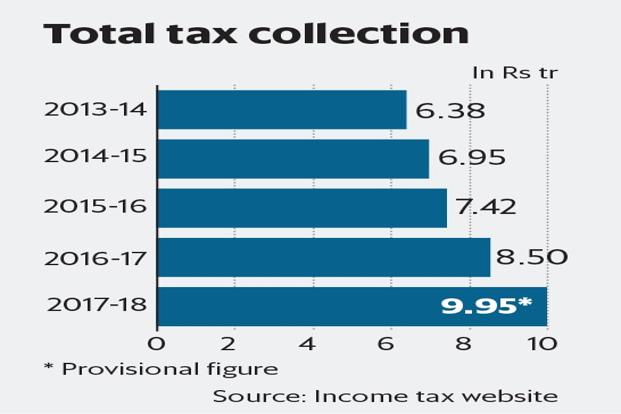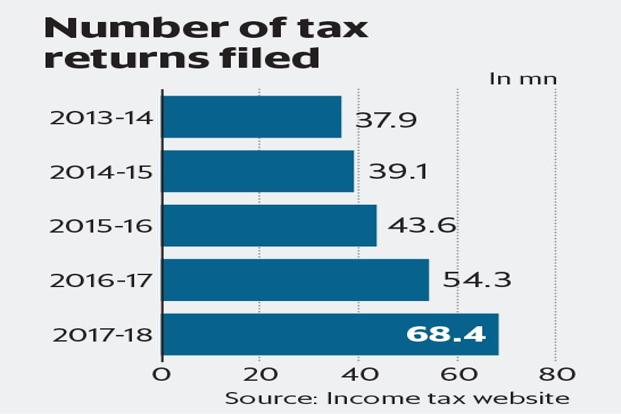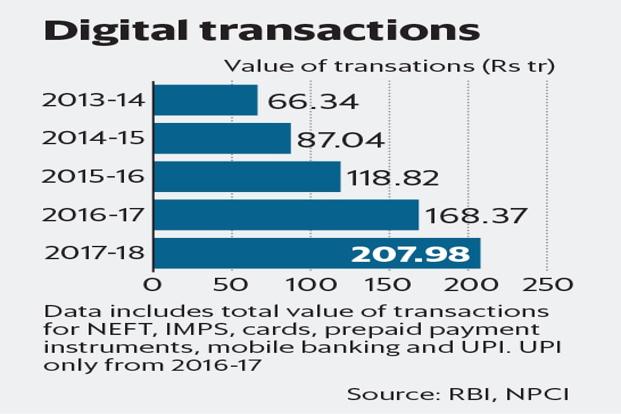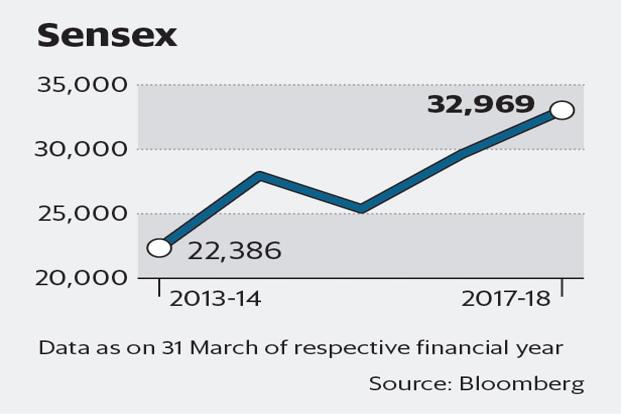The introduction of the reform-oriented proactive fiscal policy of Narendra Modi-led National Democratic Alliance (NDA) government has led the significant changes in the economy with regard to the fiscal policy aspects. Certainly, good economics does pay in the long run. Most importantly, the Narendra Modi-led NDA government made an earnest attempt to bring greater transparency in the implementation of government schemes.
The Policy Stance:
To its credit, the government has avoided shortcuts to growth using monetary and fiscal policies and most of the reforms/repair initiated in the past four years remain works in progress. These will bear fruit in the medium to long term if relentlessly executed.
Key Successes:
Direct tax compliance has shown a clear improvement in the past two years, following the income declaration scheme and demonetization. Direct tax buoyancy improved to 1.9 in fiscal 2018 from 0.6 in fiscal 2016 as growth in direct tax collections accelerated even as GDP growth slowed down. GST, despite a shaky start, is expected to speed up formalization and further push tax compliance.
According to a World Bank study, 80% of Indian adults have a bank account today which is the same as in China, and up from 35% in 2011, but the report card must take note of three other factors: formalization of the economy, financial inclusion, and digitization. None of this impacts you directly or immediately: you don’t get richer or pay less tax, but consistent efforts towards this end suggest that you get a clean and efficient economy which then has an impact on the tax rate, inflation, and financial repression.
1. Bank recapitalization
The Narendra Modi-led government had unveiled a massive Rs 2.11-lakh crore two-year road map to strengthen NPA-hit public sector banks (PSBs) which includes recapitalization bonds, budgetary support, and equity dilution. In the last three-and-a-half years, the government has pumped in more than Rs 51,000 crore capital in public sector banks.
The finance ministry has urged PSU banks to improve their performance, resolve stressed assets and lower their dependence on the government for capital. Gross NPAs in public sector banks rose from 5.43 percent (Rs 2,78,466 crore) in March 2015 to 13.69 percent (Rs 7,33,137 crore) as of June 2017.
2. Crackdown on shell firms
Intensifying its crackdown on black money, the government has collated information about 5,800 shell companies whose near zero-balance accounts saw nearly Rs 4,574 crore of deposits post note ban and Rs 4,552 crore withdrawal thereafter.
“Vital information has been received from 13 banks regarding the bank account operations and post-demonetization transactions of some of the 2,09,032 suspicious companies that had been struck off the Register of Companies earlier this year”.
The Indian economy will grow at 7.2 percent in 2018 and accelerate to 7.4 percent in the following year as a result of robust private consumption, public investment and structural reforms, but it still faces the risk of sudden capital withdrawal on account of monetary policy normalization in developed countries, a United Nations report has said.
3. Tax rationalisation
The implementation of goods and services tax (GST) is yet another move to increase transparency. GST collapses many taxes into one tax, and the idea is to reduce the tax burden and also increase compliance. This is a step towards formalizing the economy, and the result of efforts such as these has been an increase in the tax base.
The GST is the biggest tax reform being undertaken since independence. It will subsume all indirect taxes to create one rate and integrate the country into a single market. Once the GST is in force, it will replace at least 17 state and federal taxes and bring them under single unified tax structure.
GST is a comprehensive indirect tax on manufacture, sale, and consumption of goods and services throughout India to replace taxes levied by the central and state governments. It is expected to bring about a qualitative change in the tax system by redistributing the burden of taxation equitably between manufacturing and services.
4. Income Tax
In the last four years, there has been a substantial increase in the number of returns filed and the amount of tax collected. According to the income tax department, while 37.9 million ITRs were filed in FY14, 68.4 million ITRs were filed in FY18 with an increase of 80.5%.
“Removal of cumbersome processes, rationalization of tax rates, digitization, and promotion of cashless economy has been a priority of the government.”



5. Demonetisation
Last year on November 8, the Prime Minister scrapped old Rs 500 and Rs 1,000 notes to what he called a step to root-out black money and fake currency in the system. Six months later, it was noticed that the move couldn’t achieve the desired results as fake currencies were still running and corruption was still rampant.
However, the government succeeded in profiling the people by getting to know the differences between the actual flow of money and the undeclared money. In last assessment year, there were only 5.5 lakh people out of the 3.65 crore individuals who filed returns, paid income tax of more than Rs 5 lakh and accounted for 57 percent of the total tax collection. This essentially means that only 1.5 percent of those filing tax returns (3.65 crores) were contributing to 57 percent of tax kitty. The Prime Minister wanted to address this issue by bringing the unaccounted money into banking channel.
While many top-notch economists were divided over its impact on the economy, former UIDAI Chairman Nandan Nilekani hailed Modi’s demonetization move and said that it would see a massive activation of digitization of financial services in the country. He also explained as to how India’s over 80 percent workforce will come into a formal channel.
He said: “The more important thing is the economy becomes formal when everybody’s financial transactions are digitized. India is going to go from data-poor to data-rich, and that will make it more and more difficult for people to do dishonest things or to be outside the system. You will reduce the amount of black money in the system.”
6. Digitization
Ease of transaction greatly improved with the launch of mobile wallets and ultimately the Unified Payments Interface or UPI, which was launched just months before demonetization. UPI allows a user to transfer money from one bank account to another instantly using a cell phone and is set to trump the popularity of e-wallets that shot to fame right after demonetization. E-wallets allow you to make payments without using internet banking, but the wallet itself needs to be loaded first.

“Senior citizens and others who were not using digital payments have taken a lot of effort to understand digital payments. Demonetisation too has had a major impact. Some areas like government, educational institutions or housing societies who were cash- or cheque-based traditionally have now adopted digital payments in a big way.”
“The policy reforms and objective towards lowering corruption and establishing an institutional structure in certain sectors has resulted in moving towards formalization of the economy. This, in turn, aids financial inclusion and better direct tax adherence; the direct tax to GDP ratio has grown at an annualized 22% for the last three years. Along with this, focus on inflation has meant that the rally in financial assets was strong.”
7. Insolvency and Bankruptcy Code
The Modi government can pat itself on the back for implementing a comprehensive bankruptcy law, India’s version of the Chapter 11 regulation in the US Bankruptcy Code. Ever since its implementation in 2016 though, the IBC has been the subject of legislative and regulatory tinkering by parliament, the Insolvency and Bankruptcy Board of India and the Reserve Bank of India.
These encumbrances notwithstanding available data analyzed by BloombergQuint show that operational creditors have overwhelmingly outnumbered corporate debtors in using the provisions of the law—by as much as 87%—so much so that the latter are beginning to pay them even before they trigger the IBC.
8. Financial inclusion
The other significant highlight of the government is in the field of financial inclusion. According to data updated on Pradhan Mantri Jan DhanYojana’s website on 9 May, there are about 316 million beneficiaries with deposits of around Rs 81,203.59 crore.
If Jan Dhan got the economy banked, insurance through the Pradhan Mantri Jeevan Jyoti Bima Yojana (life insurance) and Pradhan Mantri Suraksha Bima Yojana (accident insurance) have given financial comfort at rock bottom prices.
9. Equities
The formalization of the economy has also meant building confidence in equities as an asset class. Today domestic flows and not foreign institutional investments (FIIs) are supporting the equity market, and more and more people are investing in equity systematic investment plans (SIPs). This is important because over the long term and on a post-tax basis fixed income, gold or real estate don’t deliver.
Equity market valuations have remained elevated throughout the Modi government term so far.


10. The Benami Transactions (Prohibition) Amendment Act
The Modi government saw a tightening of a law against black money in property. India’s long war against unaccounted-for, tax-evaded money has been through what is known as ‘benami’ transactions through the purchase of property in one person’s name but financed by another who also controls it. The 1988 Benami Property Transactions Act was weak — no powers of a civil court, no specific provisions for vesting of confiscated property, no appellate structure defined.
The Benami Transactions (Prohibition) Amendment Act, in force since 1 November 2016, empowers authorities to attach provisionally and eventually confiscate benami properties. It also carries jail terms of between one and seven years and a fine that can be up to 25% of the fair market value of the property. Within six months of the Act coming in force, the authorities identified more than 400 benami transactions, including deposits in bank accounts, plots of land, flats, and jewelry with more than 240 properties with a market value of more than Rs 600 crore being provisionally attached.
So far throughout his term, Narendra Modi government has been the forerunner in implementing people-centric fiscal policies and at the same time taking all efforts to put the economy in higher growth trajectory.

